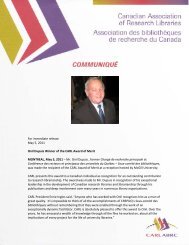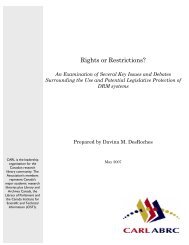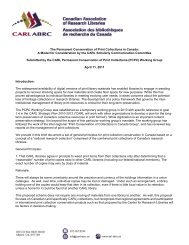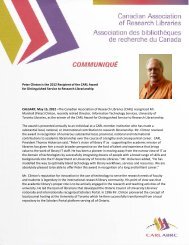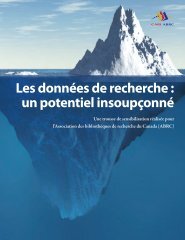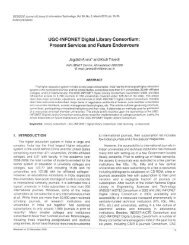PDF - CARL - ABRC
PDF - CARL - ABRC
PDF - CARL - ABRC
Create successful ePaper yourself
Turn your PDF publications into a flip-book with our unique Google optimized e-Paper software.
Special Collections in ARL Libraries<br />
March 2009<br />
The need for early intervention, or for widely shared norms for accepting digital content (for instance standard<br />
file formats, such as the ones from the LAC and PRONOM from the UK 40 ) requires a range of activities that ensure the<br />
capture and preservation of digital materials much earlier and with much less selectivity than is currently the case for<br />
analog materials. By working with those individuals who are developing information systems, repositories might influence<br />
the integration of transparent or intuitive selection and preservation tools to make the capture of materials more reliable<br />
and effective. Many of these systems, such as courseware applications that contain records of teaching, once preserved<br />
in paper filing systems and often considered ephemeral, need to facilitate better the permanent retention of products<br />
that provide evidence of the teaching and learning process. Libraries and archives working with faculty and other users<br />
have to develop new approaches to selection and preservation as they consider whether to migrate content. Working<br />
with institutional repository services, special collections professionals find that they are obliged to create mechanisms for<br />
provisional accessioning of digital materials that will allow their ongoing preservation, before decisions on their long-term<br />
value can be made. Influencing the development of tools and educating creators in effective methods of managing and<br />
saving digital materials must serve much the same function as records management – ensuring a stable body of materials<br />
from which selection can be made.<br />
Descriptive Practices and the Provision of Continuing Access<br />
Descriptive practices need to leverage existing directory schemes, much in the same way archivists use the original file<br />
plans as their basis for arranging records in physical form. Powerful full-text search engines and browsing capabilities<br />
need to be integrated into access mechanisms in ways that complement or diminish the need for traditional arrangement<br />
and description. To the extent that metadata is built into digital materials, they may become self-describing and the task<br />
of the cataloger or processor becomes more one of extracting descriptive metadata rather than creating it from scratch.<br />
Integrating digital materials that are part of larger collections that include more traditional analog materials as well will<br />
require descriptive practices that are nimble in providing integrated access to all components.<br />
Except on the smallest scale, the challenges of digital storage and preservation will be beyond the capacity of almost<br />
all special collections repositories. The volume of digital materials that will flow into special collections repositories is such<br />
that it requires collaboration with other repositories and service providers with the capacity and capabilities to house and<br />
manage them. In the context of such collaborative arrangements, the stewards of special collections must draw attention<br />
to the particular needs of their collections and their users. Preservation and retrieval capabilities will need to be defined<br />
and audited routinely in ways that are foreign for most traditional collections. Ongoing content migration, emulation, or<br />
other strategies to ensure long-term accessibility – along with media migration – need to be in place and monitored.<br />
Ongoing access to digital materials requires the development, implementation, and maintenance of search engines,<br />
interfaces, and delivery mechanisms that meet evolving user needs. Experience has shown that most developments in<br />
these areas come from large-scale commercial, scientific, and production environments other than cultural institutions<br />
and shape user expectations in ways that repositories are forced to respond to. The skills needed to take advantage of<br />
these developments are expensive because of competition from these other environments and not readily available to<br />
libraries and archival repositories. Once again, collaboration and partnerships – including the occasional possibility of<br />
transferring responsibility to other entities – will be the only way in which special collections departments can fulfill their<br />
40 See descriptions of the file format at http://www.collectionscanada.gc.ca/government/002/007002-3017-e.html and http://www.<br />
nationalarchives.gov.uk/pronom/.<br />
www.arl.org/bm~doc/scwg-report.pdf Page 27



